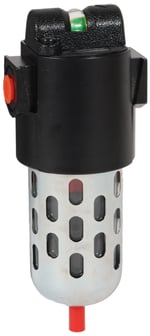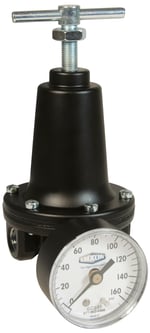Blog Post
Protecting Plant Equipment with FRLs
Jul. 6, 2022

Think about a time you interviewed for a job. You most likely researched the company before the interview, dressed to impress, and came armed with your résumé and questions to ask at the end. After all, proper preparation prevents poor performance. The same principle can be applied to air tools.
When we think of air, our minds jump to the air we breathe, which doesn't require any preparation. Compressed air, however, needs to be filtered and regulated to increase the lifespan and performance of air tools. This is done with FRLs.
Overview
FRL stands for filters, regulators, and lubricators. They are also called prep units, trios, combo units, and piggybacks. Regardless of the name used to describe the parts, the purpose remains the same.
Compressed air is moist and dirty. Filtering and regulating the air before a tool prevents contamination and makes it safe to use throughout the compressed air system. In addition, the proper performance of air tools relies on adequate lubrication, which rounds out the need for FRLs.

Filters
At any plant or workshop, the presence of dust and dirt is inevitable. Pulling dirty air into a compressed air system is not ideal and can hinder the performance, as well as damage and/or shorten the lifespan of the tool. A filter is used to remove contaminants such as dust, condensation, and pipe scale.
Dixon offers filters in a variety of sizes ranging from ¼ inch to 2 inches, depending on the type. There are two main types of filters: general-purpose and coalescing. The main difference between the two is the micron rating.
Microns are a unit of measurement used to quantify the number of particulates a filter will let through. The higher the micron rating, the more particles are allowed through, meaning less matter is filtered out. General-purpose filters range from 5 to 40 microns. A coalescing filter is rated for .01 to .003 microns. This means a general-purpose filter removes condensation and particles down to 5 microns, while a coalescing filter can remove oil mist, oil aerosols, and microscopic particles down to .003 microns for cleaner, drier air.
Multiple filters can be used in an operation. This is done to increase the amount filtered out. A general-purpose filter is used before a coalescing filter to remove condensation and larger particles. Then, a coalescing filter further refines the air and eliminates any lingering particles to ensure the highest quality air is used in the pneumatic system.
A paint booth is a good example of a situation where combining filters is beneficial. Paint, oil, and water are not a good combination. Starting with a 5-micron filter as a pre-filter, and then using a coalescing filter ensures the air is completely free of unwanted particles that would contaminate the painting process.
 Watts Standard Regulator
Watts Standard Regulator
Regulators
Once the air is clean, cool, and dry, the next step is to use a regulator. Regulators adjust and control the air pressure to ensure tools down the line do not exceed their maximum operating pressures.
Think of a regulator like cruise control in a vehicle. Driving 25 miles per hour, then 65 mph, then 40 mph, then up to 80 mph, within a short time frame on the same road would negatively impact gas mileage and decrease the lifespan of the vehicle. Using cruise control allows a vehicle to drive at a steady speed to maintain decent gas mileage and reduce the wear and tear on the vehicle. Regulators promote stable pressure and airflow in pneumatic systems. This helps conserve energy and ultimately saves money by not using excess compressed air. In addition, regulators help maintain safety requirements.

Lubricators
Lubricators are used to help extend the life of air tools. Just like a car needs motor oil to run properly, adequate lubrication ensures pneumatic tools function at their best. Lubricators provide the tool with a constant supply of oil. There are two types of lubricators: oil fog and micro fog.
Oil fog lubricators are designed to deliver oil to a single tool being used close to the FRL. This type of lubricator emits large drops of oil visible in the sight dome before moving downstream. An advantage of oil fog lubricators is they can be filled while under pressure.
Micro fog lubricators are designed to work with multiple tools. The oil is dispersed as mist and drifts down the air line. Only 10% of what is seen in the sight dome goes downstream. The remainder falls back into the lubricator bowl for reuse. The air must be shut off before supplying the lubricator with oil.
Using the proper oil for lubricators is imperative. Operators should only use air tool lubricant. Any petroleum-based, non-detergent lightweight oil, such as SAE 10 or 150SSU is acceptable.
Installing FRLs
FRLs should be installed in the same order their name suggests filter, regulator, then lubricator. This order of installation is important because it would be pointless to lubricate an air tool only to filter out the lubrication immediately afterward.
FRLs should be mounted as close to the tool as possible to maximize the number of particulates removed from the compressed air. In addition, the unit should be mounted in an easily accessible location to make draining the filter and refilling with lubricant less complicated. If a unit must be mounted in an area that is difficult to reach, consider purchasing a larger unit so you do not have to access it as often. A bigger unit also has the added benefit of increased airflow volume and more versatility for tools.
Things to Consider Before Purchasing
It is important to make sure you select the right FRL setup for your specific application. Before purchasing, consider the following factors:
- Size of airline piping
- Rate of flow in standard cubic feet per minute (SCFM)
- Metal or transparent bowl for the filter and lubricator
- Auto drains or manual on the filter
- Accessibility to refill or drain
- Number of tools being used
- The amount being filtered out
Dixon’s Inside Air Solutions
Dixon offers a copious amount of FRLs to meet your application needs.
Wilkerson
Series 1
Watts
Summary
The combination of filters, regulators, and lubricators in pneumatic systems is an efficient and cost-effective way to protect plant equipment. FRLs provide air tools with the proper lubrication and clean air at the right pressure to optimize performance. This increases the lifespan of inside air tools and provides protection from contamination. After all, proper preparation prevents poor performance.
Ready to protect your air tools? Check out our FRLs online, or contact a Dixon specialist for more information.
 SG | en
SG | en